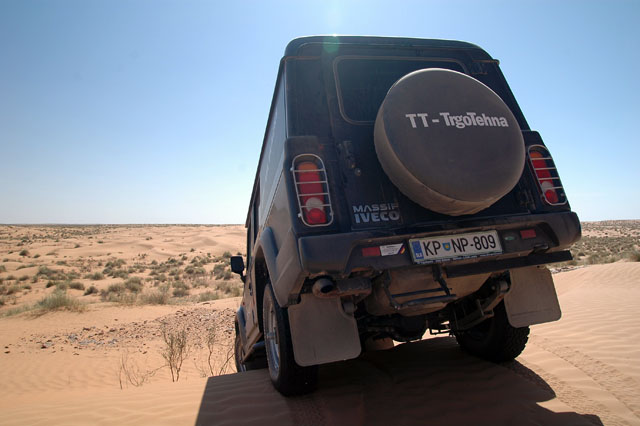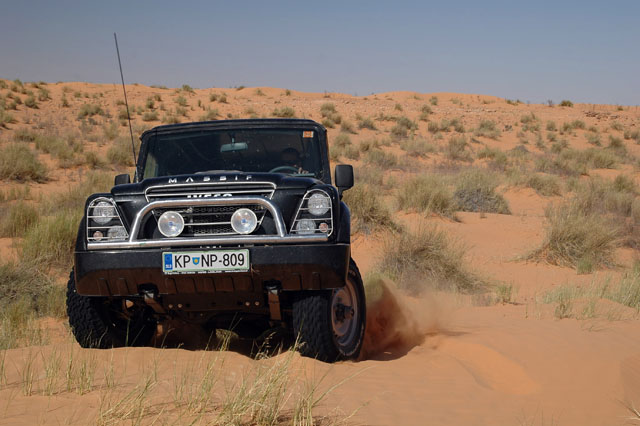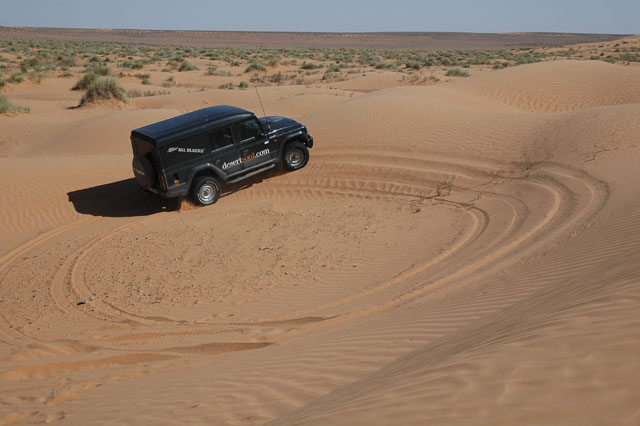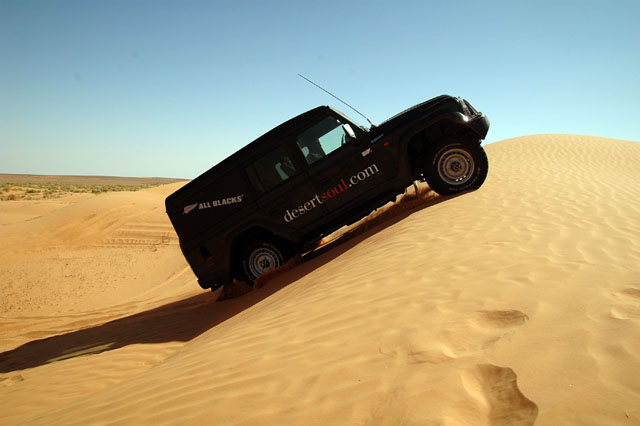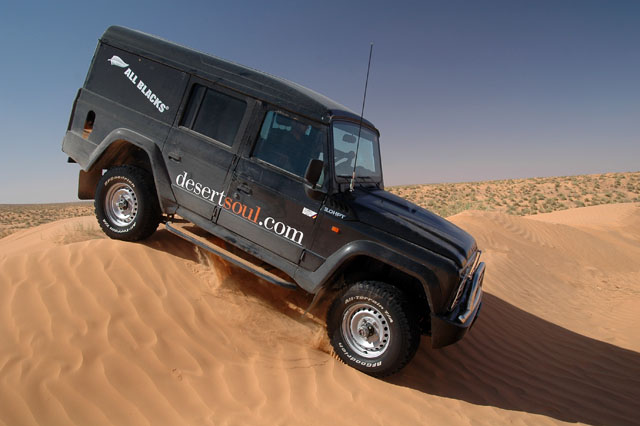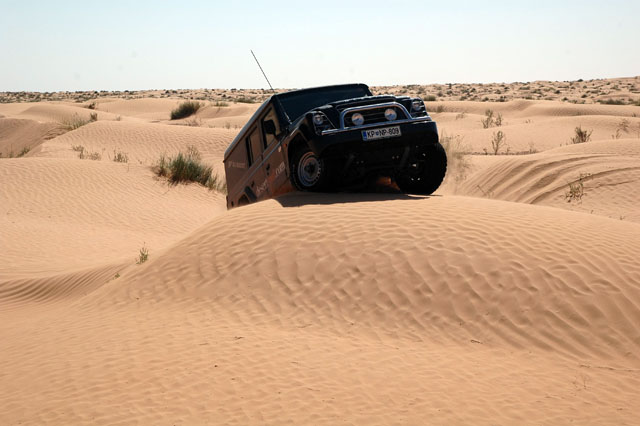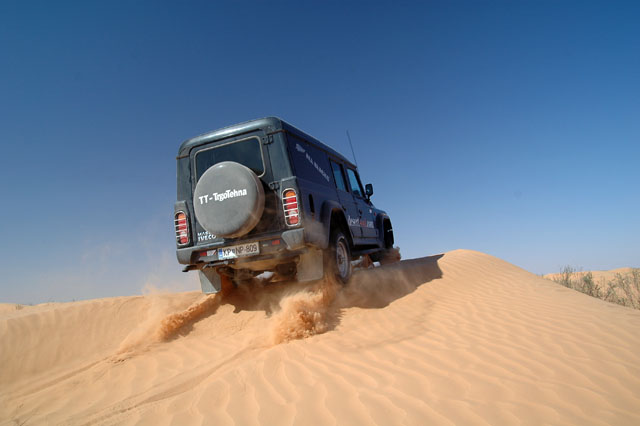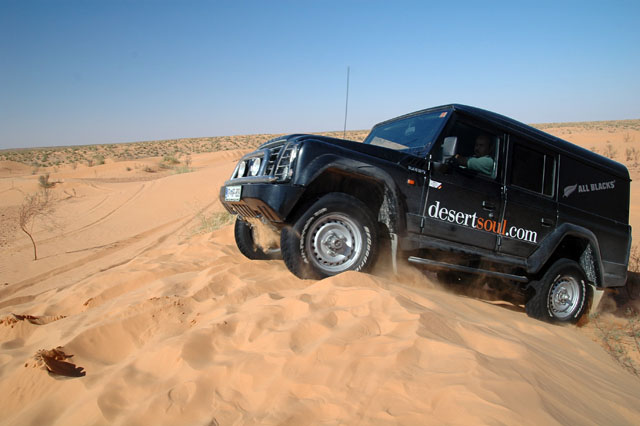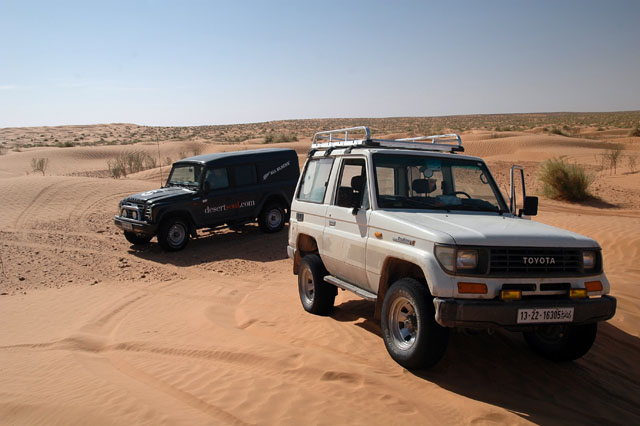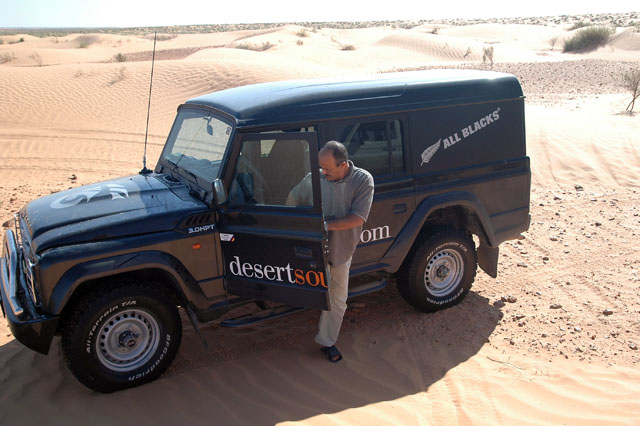ETUDE POUR LE MASSIF
21.08.2015
On Friday, the only day-off in Libya, Uroš and I left for az-Zintan after a hard but successful week in Tripoli, to meet our friend Amer Goula. Together we drove 80 km into the desert to get some more pictures of the new off-road vehicle Iveco Massif.
In this entry, considering the nature of our current visit to Libya, I shall focus only on the day off in the desert and on our impressions of the Iveco Massif.
Already on our way to Civitavecchia, its 2,998 cc engine with a power output of 130 kW, taken from Iveco’s Daily light commercial vehicle range, pleasantly surprised us with its exceptional amount of torque. Even at top speed – 164 km/h according to the GPS device (the car’s speedometer shows a little more) – the vehicle handles well and is still comfortable to ride in.
Appearances can be deceiving and the uncomfortable-looking seats brought us to Civitavecchia (over 700 km) in pretty good condition. Despite their high lateral cross-section, the tyres that we inflated to 5 bar maintained adequate lateral stability even on the winding regional roads of Tuscany. Here I must add that we were in a rush to catch a ferryboat, which we did in the nick of time.
Care needs to be taken when braking at high speeds as this makes the off-roader lose some of its longitudinal handling, which requires correcting with the steering wheel and brake pedal.
Fuel consumption came as a big surprise to me and Uroš, seeing that we normally drove 140 km/h, sometimes even faster.
The calculated fuel consumption after stopping in central Tunisia in the middle of the night (we left from Fernetiči with a full tank) was 13.3 l/100 km (21.24 MPG (Imp)), which is better than expected considering the driving style.
The sixth gear likely contributed a great deal to this result. The Massif has a detachable front axis part-time four-wheel drive, something we have seen in certain Land Cruiser models, including gear reduction and rear differential lock.
The lowest pressure in our BF Goodrich All Terrain 235/85R16 tyres was 0.9 bar – we used it to overcome Tunisian dunes at noon. The car will surprise you with its endless amount of power and torque, almost completely eliminating having to shift into second gear when driving over dunes, even when driving in high ratios.
Thanks to its large radiator and ventilator, it only takes a few seconds for the engine to cool down to its normal operating temperature.
I would, though, prefer a more powerful air conditioner in this environment for when I return to the cabin after shovelling sand under the Saharan sun in late May. Otherwise, the air conditioner worked perfectly fine, at least for the crew sitting in front.
I would not change much about this off-roader. The only sources of annoyance are some niggling details. The tailgate struts are not powerful enough to keep the tailgate open when the car is inclining to the left. Mechanical supports would be a welcome addition. The front door locks are situated exactly where one would want to rest their elbow. The side steps are probably not a part of series-mounted equipment and present an obstruction when trying to dig the vehicle out of sand.
Retractable steps would be a more useful choice. The rear window is also a problem – it reflects the lights of oncoming traffic because of its perpendicular placement, making side mirrors the only reliable sources of information on the traffic behind the vehicle.
This, however, is not limited to the off-roader we tested. On the other hand, the vehicle has another flaw, which is not trivial: my kingdom ... well, perhaps a county, for a smaller turning circle!
Besides the windshield which is completely flat and thus easy to replace, the polyester roof is also praiseworthy as it permits satellite telephony signals to pass through regardless of the direction the vehicle is facing.
The vehicle has a live front axle and its wheels are placed a little further toward the front compared to the Defender, allowing for a better approach angle.
All in all, this is an off-road vehicle with a load capacity of around a tonne and with a surprisingly flexible engine that is great fun to drive over dunes and terrain (if the tyres are fully inflated, adding too much throttle will make the vehicle’s rear axle lose traction, but it is easy to bring under control and makes driving very fun).
The massive black car evokes a great deal of admiration in cities and is not difficult to park despite its length.
To conclude, the Spanish and the Italians have succeeded in making a very attractive vehicle. For more information about the story: Iveco Santana
In this entry, considering the nature of our current visit to Libya, I shall focus only on the day off in the desert and on our impressions of the Iveco Massif.
Already on our way to Civitavecchia, its 2,998 cc engine with a power output of 130 kW, taken from Iveco’s Daily light commercial vehicle range, pleasantly surprised us with its exceptional amount of torque. Even at top speed – 164 km/h according to the GPS device (the car’s speedometer shows a little more) – the vehicle handles well and is still comfortable to ride in.
Appearances can be deceiving and the uncomfortable-looking seats brought us to Civitavecchia (over 700 km) in pretty good condition. Despite their high lateral cross-section, the tyres that we inflated to 5 bar maintained adequate lateral stability even on the winding regional roads of Tuscany. Here I must add that we were in a rush to catch a ferryboat, which we did in the nick of time.
Care needs to be taken when braking at high speeds as this makes the off-roader lose some of its longitudinal handling, which requires correcting with the steering wheel and brake pedal.
Fuel consumption came as a big surprise to me and Uroš, seeing that we normally drove 140 km/h, sometimes even faster.
The calculated fuel consumption after stopping in central Tunisia in the middle of the night (we left from Fernetiči with a full tank) was 13.3 l/100 km (21.24 MPG (Imp)), which is better than expected considering the driving style.
The sixth gear likely contributed a great deal to this result. The Massif has a detachable front axis part-time four-wheel drive, something we have seen in certain Land Cruiser models, including gear reduction and rear differential lock.
The lowest pressure in our BF Goodrich All Terrain 235/85R16 tyres was 0.9 bar – we used it to overcome Tunisian dunes at noon. The car will surprise you with its endless amount of power and torque, almost completely eliminating having to shift into second gear when driving over dunes, even when driving in high ratios.
Thanks to its large radiator and ventilator, it only takes a few seconds for the engine to cool down to its normal operating temperature.
I would, though, prefer a more powerful air conditioner in this environment for when I return to the cabin after shovelling sand under the Saharan sun in late May. Otherwise, the air conditioner worked perfectly fine, at least for the crew sitting in front.
I would not change much about this off-roader. The only sources of annoyance are some niggling details. The tailgate struts are not powerful enough to keep the tailgate open when the car is inclining to the left. Mechanical supports would be a welcome addition. The front door locks are situated exactly where one would want to rest their elbow. The side steps are probably not a part of series-mounted equipment and present an obstruction when trying to dig the vehicle out of sand.
Retractable steps would be a more useful choice. The rear window is also a problem – it reflects the lights of oncoming traffic because of its perpendicular placement, making side mirrors the only reliable sources of information on the traffic behind the vehicle.
This, however, is not limited to the off-roader we tested. On the other hand, the vehicle has another flaw, which is not trivial: my kingdom ... well, perhaps a county, for a smaller turning circle!
Besides the windshield which is completely flat and thus easy to replace, the polyester roof is also praiseworthy as it permits satellite telephony signals to pass through regardless of the direction the vehicle is facing.
The vehicle has a live front axle and its wheels are placed a little further toward the front compared to the Defender, allowing for a better approach angle.
All in all, this is an off-road vehicle with a load capacity of around a tonne and with a surprisingly flexible engine that is great fun to drive over dunes and terrain (if the tyres are fully inflated, adding too much throttle will make the vehicle’s rear axle lose traction, but it is easy to bring under control and makes driving very fun).
The massive black car evokes a great deal of admiration in cities and is not difficult to park despite its length.
To conclude, the Spanish and the Italians have succeeded in making a very attractive vehicle. For more information about the story: Iveco Santana
